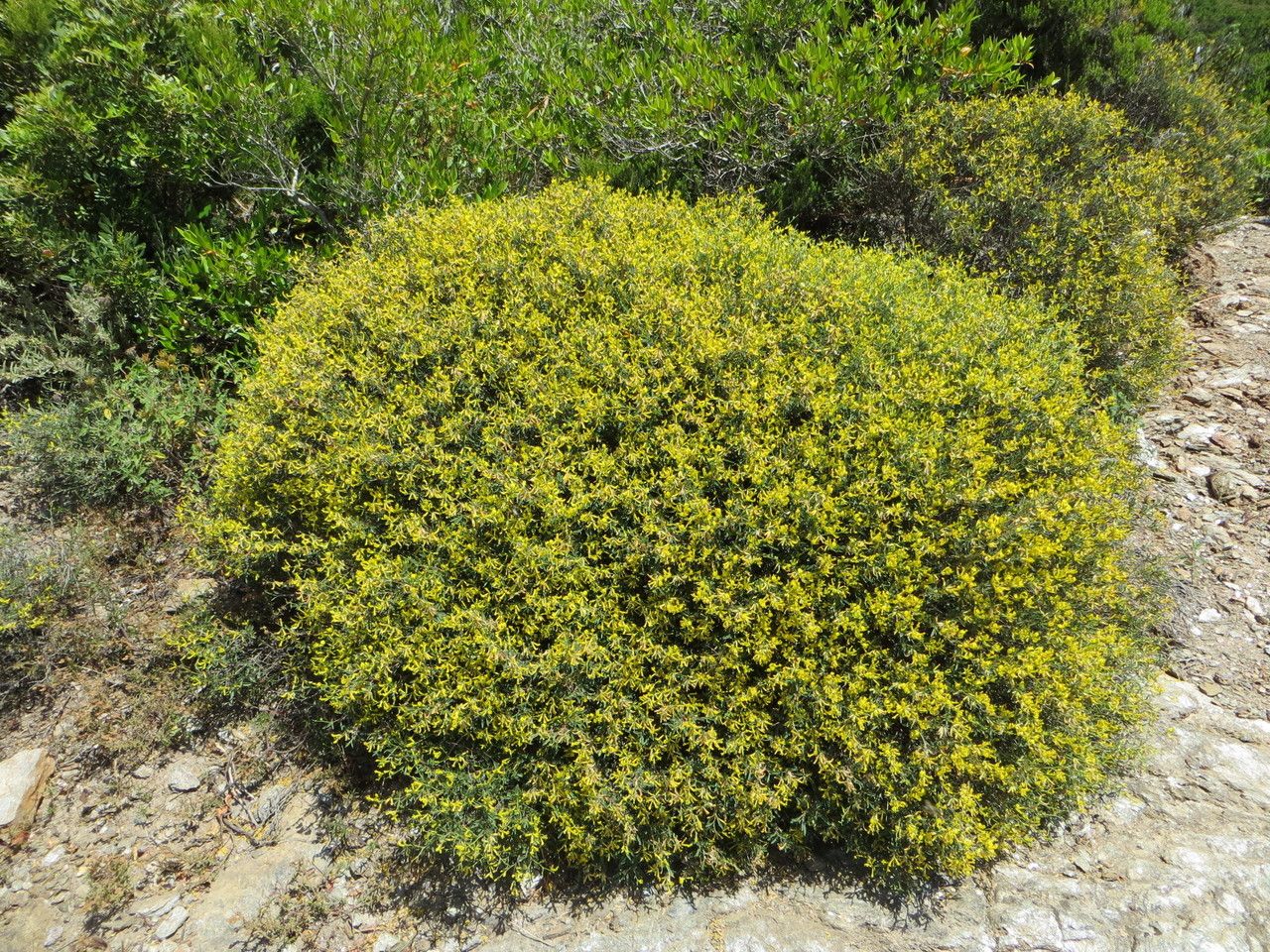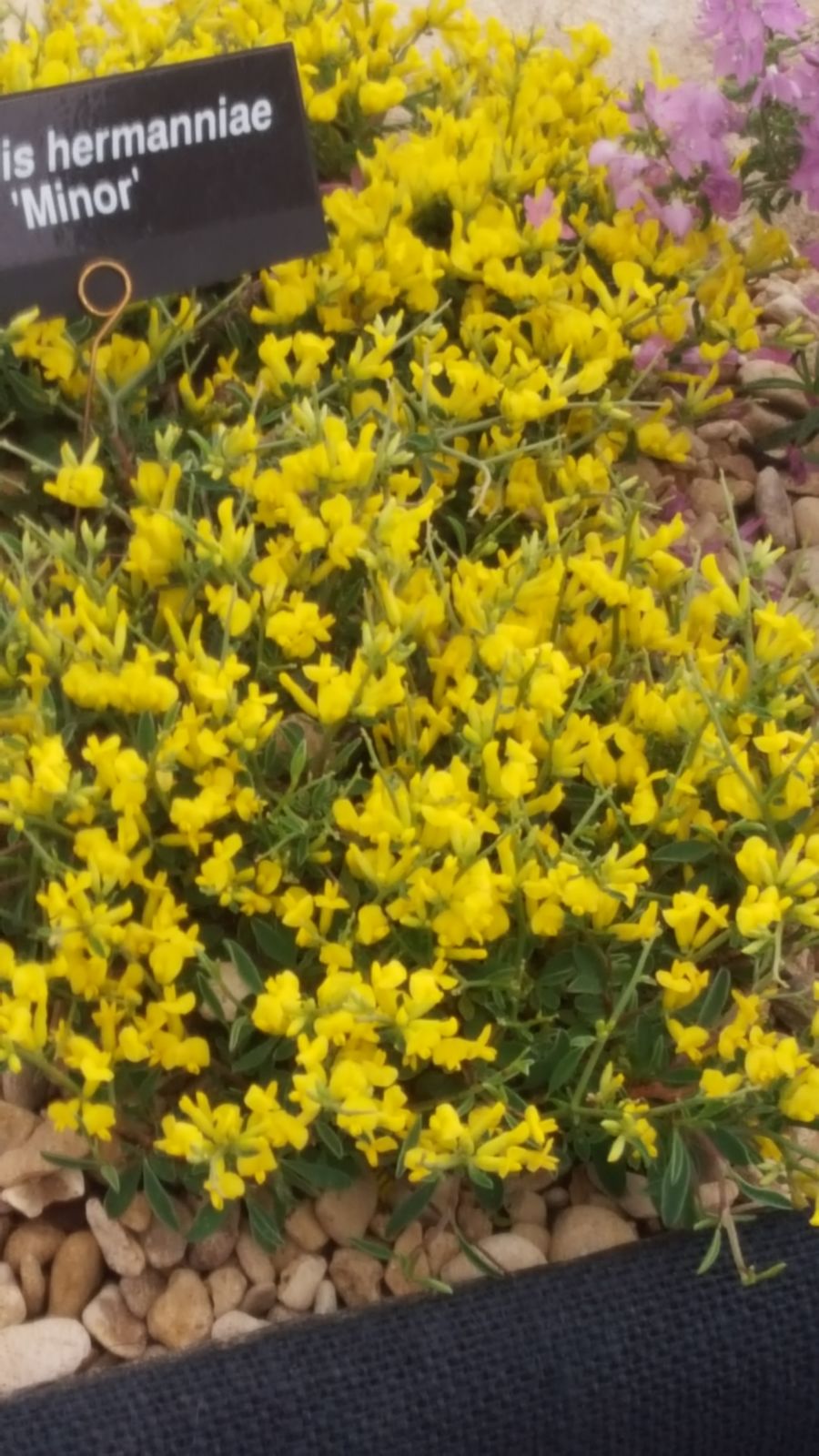Hermann's Broom
anthyllis hermanniae
Also known as: ["Hermann's Broom","Spanish Broom"]
Overview
A deciduous shrub native to the Mediterranean region, characterized by its yellow flowers and spiny leaves.
Benefits & Perks
["drought tolerant","wildlife attractant (bees, butterflies, birds)","aesthetic foliage"]
Botanical Classification
| Phylum: | Magnoliophyta |
| Class: | Magnoliopsida |
| Order: | Fabales |
| Family: | Fabaceae |
| Genus: | Anthyllis |
| Botanical Name: | Anthyllis hermanniae |
Plant Characteristics
Basic Information
- Category: Shrubs
- Suitable Location: rock garden or sunny, open border
- Suitable For:
- Is Weed: No
- Allergenicity: low
Environmental Needs
- Climate: {"temperatureRange":"5–35°C"}
- Hardiness: {"zones":"7–9"}
- Misting: rarely required, only if ambient humidity is very low
- Drainage: Fast-draining to prevent waterlogging.
- Soil Type: Well-draining, sandy, or gravelly soil with low organic matter.
Maintenance Level
- Maintenance Level: moderate
- Toughness Level: high
- Pruning Frequency: Annually in late winter or early spring before new growth begins.
- Pruning Intensity: Moderate pruning to shape the plant and remove up to one-third of old growth.
Care Details
Ideal Sunlight Coverage:
Full sun (6–8 hours of direct sunlight daily). Adjust for intense summer heat by providing partial afternoon shade.
Sunlight Tolerance Tips:
Acclimate plants gradually to full sun if moved from shade. Protect from scorching by providing shade during peak summer heat. Outdoor placement is ideal, but ensure protection from harsh winds.
Care Requirements
Care Difficulty
moderatemoderate
Sunlight
full sun
Full sun lover; avoid deep shade; protect from intense midday sun in summer.
Watering
every 7–10 days during active growth, reduce in winter
Water deeply but infrequently; ensure excellent drainage; avoid overhead watering to prevent fungal issues.
Soil
well-drained, sandy or rocky soil
pH: Slightly alkaline to neutral (pH 7.0–7.5).
Ensure excellent drainage; avoid heavy clay soils; use a mix suited for succulents or Mediterranean plants.
Temperature
Prefers warm temperatures (65–85°F / 18–29°C). Tolerates mild frosts but thrives in Mediterranean-like climates.
Protect from frost; water early to avoid heat stress; adjust care based on seasonal temperature shifts.
Fertilizing
every 4–6 weeks during spring and summer
Fertilize only during active growth; avoid over-fertilizing; use a cactus or succulent-specific formula.
Propagation
Methods
Stem cuttings or division. Stem cuttings are more common for home growers.
Step-by-Step Propagation Guide
- Take a healthy cutting.
- Let it callus for a few days.
- Apply rooting hormone.
- Plant in propagation medium.
- Maintain humidity and warmth.
Best Time: Spring or early summer when the plant is actively growing.
Environment
Warm (70–75°F / 21–24°C), high humidity (60–70%), and bright indirect light.
Medium
Well-draining mix of perlite and cactus/succulent soil.
Hormone
Recommended to use a rooting hormone for faster and more reliable rooting.
Timeline
Roots typically form in 3–6 weeks; establishment may take an additional 2–3 months.
Tools Needed
Sharp pruning shears, rooting hormone, small pots, propagation tray, humidity dome.
Quick Tips
Use sterile tools; maintain consistent moisture; provide bottom heat for faster rooting.
Pruning & Repotting
Pruning Guide
Method
Selective pruning of stems to encourage branching; remove dead or damaged parts.
Pruning Plan
Prune to maintain shape, encourage bushier growth, and remove dead or weak stems.
Tools
Sharp, clean bypass pruners, pruning shears, gloves.
Checklist
Sterilize tools; prune before active growth; remove dead/damaged stems; shape the plant evenly.
Repotting Guide
Best Season
Spring, just before the growing season starts.
Pot Size
Increase pot size by 2–3 inches (5–7 cm) in diameter.
Method
Use fresh, well-draining soil; gently tease apart roots; place in a pot with drainage holes; water lightly after repotting.
Suggestions
Repot every 2–3 years or when the plant becomes root-bound. Essential for maintaining vigor and preventing overcrowding.
Checklist
Choose a new pot with drainage; prepare fresh soil mix; handle roots gently; water sparingly post-repotting.
Advanced Care Tips
Watering Mastery
Watering Checklist
Check soil moisture before watering; water deeply at the base; ensure excess water drains away; reduce frequency in winter.
How to Apply Water Properly
Water directly at the root zone until water drains from the bottom, ensuring even saturation without waterlogging. Water in the morning to allow foliage to dry during the day.
Watering Schedule Tips
Water sparingly, allowing soil to dry completely between waterings. Reduce watering significantly in winter to prevent root rot.
Soil Improvement
Add coarse sand, perlite, or pumice to improve drainage; incorporate small amounts of compost for fertility.
Temperature Stress Management
Signs of Temperature Issues
Chlorosis or leaf drop in excessive heat; stunted growth or browning in cold stress.
Cold Stress
Low temperatures slow growth and can cause root damage or dieback, especially in wet conditions.
Solution: Provide winter protection with mulch; move potted plants to a sheltered location; avoid overwatering during cold periods.
Hot Stress
Excessive heat can lead to wilting, leaf scorch, or reduced flowering if not managed with proper watering and shade.
Solution: Water deeply in the morning; provide light afternoon shade; ensure good air circulation to reduce heat stress.
Fertilizing Guide
Fertilizing Checklist
Use diluted fertilizer; apply during growing season; avoid winter feeding; monitor for signs of over-fertilization.
Fertilizing Method
Use a balanced, low-nitrogen fertilizer diluted to half strength. Apply sparingly in spring and summer, avoiding winter fertilization.
Common Problems & Solutions
Toxicity Warning
Cats
Non-toxicAnthyllis hermanniae is not considered toxic to cats. The plant does not produce known toxins that would cause adverse effects upon ingestion or contact by felines.
⚡ Toxic If:
None
Dogs
Non-toxicAnthyllis hermanniae is not considered toxic to dogs. There are no documented cases or studies indicating harmful effects from exposure or ingestion of this plant by canines.
⚡ Toxic If:
None
Humans
Non-toxicAnthyllis hermanniae is not known to exhibit toxic properties to humans under normal circumstances. The plant does not produce known toxins that would cause adverse effects upon ingestion or contact.
⚡ Toxic If:
None
Frequently Asked Questions
Q: Is Anthyllis hermanniae toxic to pets?
A: There is insufficient data on its toxicity to pets.
Q: How often should Anthyllis hermanniae be watered?
A: It is drought-tolerant and requires infrequent watering once established.
Q: Does Anthyllis hermanniae attract wildlife?
A: Yes, it attracts bees, butterflies, and birds due to its nectar-rich flowers.
Quick Reference
| Family: | Fabaceae |
| Care: | moderate |
| Light: | full sun |
| Water: | every 7–10 days during activ |
Get Expert Care Tips
Download the Plantious app for personalized care reminders and plant identification!
Google Play App Store







